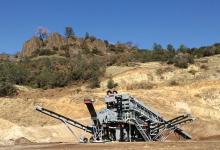In 2009, with another local site running out of mineable reserves, Dexter Sand and Gravel’s area manager Mike Martin, and mining engineer Scott Jinks, started looking for a new site, and broke ground at the Dexter site in the US in February 2012. Today, the site is a flourishing operation, producing concrete and masonry sand at the rate of more than 180tonnes/hr.
“This site is a great sand deposit with a small amount of gravel that is easily separated,” says Martin.
“The challenge with this deposit is that it contains trace amounts of lignite," Martin says. Lignite is a material similar to soft coal, and it causes problems with concrete sand because it is lighter than the sand and essentially pops out as the concrete sets, causing voids in the finished concrete.
[caption id="attachment_79612" align="alignright" width="300"] A McLanahan Lites-Out system is helping to produce high quality concrete and masonry sand[/caption]
A McLanahan Lites-Out system is helping to produce high quality concrete and masonry sand[/caption]
Concerned with the quality issues caused by lignite, Martin and Jinks decided to work with McLanahan Corporation, coming together to design the plant and make sure the equipment could separate the lignite and make the desired products.
A McLanahan Lites-Out system, also known as a Flat Bottom Classifier, was settled on to remove the lignite. The system uses a pulse-type discharge to induce a jigging action that helps dilate the bed and frees the coarser organics such as lignite through the fluidised bed.
McLanahan says the gravitybased process does not require chemicals, or something like Magnetite, to help the separation. And that the same technology can be used for soil remediation or to separate construction debris.
“The Lites-Out Flat Bottom Classifier has a small footprint on the location because it is flatbottomed along with lower head height, which decreased our pumping horsepower needed,” says Martin.
“The machine features a diverter box that allows Dexter to make concrete and masonry sand at the same time, saving time, energy and money.”
The Lites-Out System removes +50 mesh lignite from a -4 mesh feed to achieve the published specifications for lignite-free sand. McLanahan has also installed a warning system to ensure lignite does not enter into the concrete sand.
“The system helps us gradation-wise with the concrete sand but also removes any trace amounts of lignite. This makes a high-quality concrete sand which is saleable for transportation projects and general construction projects,” says Martin.
First First published in Aggregates Business Europe & International




